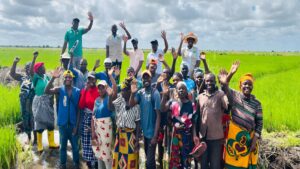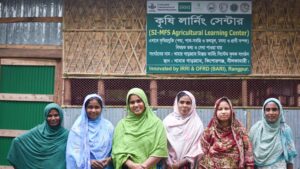
Back in 2006, a farmer in the town of Victoria in the Philippine province of Laguna asked his local government to assist him in sending a message to the International Rice Research Institute (IRRI): “Train us. Soon after, Mr. Casiano Estrella Jr. and his fellow farmers in his municipality went through the Cyber-Village Project—a coaching of farmers on how to get important farming information from an Internet-based portal of rice technologies called the “Pinoy Rice Knowledge Bank” (Pinoy-RKB).
Pinoy-RKB
The project, now in its second phase, started in 2006 and has reached about 3,500 farmers in 12 municipalities across the country. IRRI is working closely with the Philippine government, through the Philippine Rice Research Institute (PhilRice), in carrying out the project. The Pinoy-RKB is a country-specific off-shoot of the Rice Knowledge Bank, which shares information about best practices, as well as updated technologies for all stages of rice production, with farmers (see Banking on our rice knowledge ).
On a rainy morning in August 2011, a second group of rice farmers from Victoria was about to get the same training as their fellow farmers did 5 years back. The local farmers’ enthusiasm could be traced to one man: Casiano Estrella Jr., or Mang Jun, as he prefers to be called.
A community man

Mang Jun is a high school graduate who never stopped learning. His thirst to learn was fueled by another passion: serving his community.
A young Jun landed his first job as an assistant to community projects at the University of the Philippines Los Baños (UPLB), located a few kilometers north of Victoria. He went on to work for UPLB’s sister campus in Manila as a clerk. His stint with UPLB, however, stirred his heart for the community, something that never really left him. So, he left his job at UP Manila, and returned to Victoria.
He took his desire of serving his community further by running for municipal councilor as an independent candidate in 1995, and won. During this time, Mang Jun established ties with the municipal agriculture system, which proved helpful for him several years after he embarked on rice farming. “I ran again in the following election for a second term, but I lost,” Mang Jun said. “That was the time when I decided to become a rice farmer.”
Banca-Banca

To aid in his early years as a rice farmer, Mang Jun applied for membership in a local rice farmers’ group named Banca- Banca Multi-Purpose Cooperative.
“I wanted to avail of the credit privilege to start up my farm,” he said. But as Mang Jun would realize soon, he had established himself as a community leader well enough that, in 2003, not only was he accepted into the cooperative, but was voted to lead the organization.
Train them
As a leader, Mang Jun looked to educating his fellow farmers as a way to tackle the problems on their farms.
“I’d long heard about IRRI when I was still with UPLB, and that it is located right in our backyard,” he recalls. It was during one of his municipal governmentsponsored tours to the Institute that Mang Jun recalls a “light bulb” moment.
“I heard during one of my field trips to IRRI that they were conducting a project called ‘cyber-village,’” he said. After understanding that the project targets different municipalities across the country to introduce rice technologies through the IRRI Rice Knowledge Bank, Mang Jun wanted his fellow rice farmers in Victoria to have such training.
“I asked for the help of our local municipal agriculturist and provincial officials to facilitate Victoria’s rice farmers’ training,” he said.
Farmers’ learning hub
“We have a center in our community where we have reading materials and a computer that allow us to access the Rice Knowledge Bank,” Mang Jun said. “Before, we could not even identify a disease properly so we sprayed pesticides anytime we wanted.
“Because of the training we had, and the constant checking with the RKB, we now know that you should not just spray anytime you want to because there are insects in the field that actually help fight pests,” he added.
Mang Jun said that, after their training, they became aware of integrated pest management (IPM), and promptly practiced it. They soon realized that IPM was not only good for the farm’s health, but it also kept their overhead costs lower than before (see also Managing pests with nature).
Now, they can balance what they heard from the pesticide agents who used to visit them with what they know about best practices in pest management.
Due credit
Perhaps the clearest indication of change that Mang Jun observed in his community is that his fellow rice farmers can now be trusted by their cooperative’s credit system with bigger loans.
“Before we applied these technologies on our rice farms, our credit program in the cooperative lended only about Php18,000 (about US$400) per crop to a farmer for fear that he might not be able to pay it back,” he said. “But now, after improving the ways they manage their rice, their yields have increased over the years, and so the average credit that our cooperative now gives to farmer-members increased to between Php30,000 and 50,000 ($1,300–$2,100).”
Changed
“We have always been committed to helping the Philippines’ rice-growing sector,” said Mr. Julian Lapitan, head of IRRI’s National Programs Relations. “We are happy to see a positive response to our efforts in communicating good rice-growing practices to Filipino farmers.
As I said my goodbyes to Mang Jun, he joined the rest of his fellow farmers and Victoria municipal extension staff, who at the time were inside a local Internet cafe, receiving tutorials from IRRI and PhilRice staff on how to use the newly launched technology on managing the application of nutrients on their rice farms. “Things have really changed around here,” he smiled.
___________________________________________
Ms. Ma. Lizbeth Baroña is a science communication specialist with IRRI’s Communication Unit.








